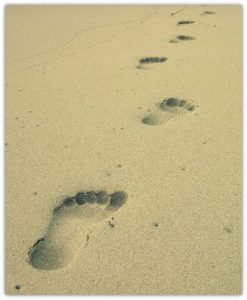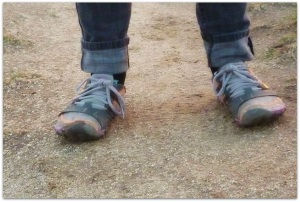Barefoot Running Shoes: What They Are and a Happy Ending
Dear A & H…Can’t write about running without mentioning shoes. Since a favorite is barefoot running shoes, it’s only fitting to start with them. ت
Less is More for Some Runners
Barefoot running shoes have an undeniable loyal following.
We might be small in number but for those of us who swear by them, we definitely would feel a void in our running lives without them.
Understanding this devotion is difficult for some to understand, though.
These folks may see odd-looking shoes that don’t seem quite worth the hype or price.
How can so much of nothing be any good? They had their 15 minutes of fame. It’s time to move on.
Well, lend an ear (eye?) and let me tell you a little story. 🙂
But first…
I have a question for you.
When was the last time you looked at the bottom of your feet? You know, your soles.
 Even if it’s been a while…even if it never crosses your mind except to inspect a blister or when nose, not eyes, makes their presence known. 🙂
Even if it’s been a while…even if it never crosses your mind except to inspect a blister or when nose, not eyes, makes their presence known. 🙂
Soles and the feet they are attached to are a wonderous thing.
Just the simple act of walking barefoot on a beach gives one opportunity to pause and appreciate…seeing that iconic footprint shape brought about by intricate and refined architecture…
Beautiful.
Granted, time and use can strip away much of their attractiveness and internal workings but, if taken good care of…
Think of the possibilities.
But, right now, do we give them their due respect and attention?
If feet, time after time, are called upon — expected — to perform their important functions without fail (hopefully until our last breath), how can this amazing people-moving equipment be designed any better? If it could, wouldn’t we have different feet by now?
Hmm…there’s something important to be explored there.
When we entered this world, two naked feet was all we were given to start us on our way.
Hmm…there is something to trust there.
No Matter How Beautiful in Theory, Bare Feet Aren’t Always Practical
No doubt, throughout most, if not all, of human history, using various materials, we have been attempting to cover our feet.
Safety reasons seem to be the primary reason. Thorns, rocks, glass, gum, microorganisms, dog poo, tiger poo, etc. It’s pretty self-explanatory that we strongly desire something to come between our feet and the unpleasant things we might come across during the course of our days.
Then there are the aesthetic reasons. It may all come down to vanity but we like our feet to look attractive and, if we gain a few inches in the process, so much the better.
However, when it comes to running, shoes pose a conundrum.
In the pursuit of comfort and performance, the running industry has offered so many interpretations of what is best regarding effective shoe “materials” and “style,” that it’s quite challenging zeroing in on that ideal pair that will work best for “me.”
Why does it have to be so hard? 😕
The Tribulations of Purchasing Running Shoes: A True Story
Since picking up running in the early 90s, buying shoes was never much fun and always seemed to be a kind of hit or miss endeavor.
Thankfully, I got lucky with my first pair. They were comfortable wherever I ran. I was pleased and stayed loyal to the brand. But, alas, the shoe company decided not to make that particular model anymore.
Bye, Jazz. 😕
As luck would have it, later purchases were not so favorable. One company made a pair of shoes that became so uncomfortable that they should have renamed this particular model “Synonymous With Pain.” Not surprisingly, for many, many, years I avoided purchasing from this company. Kind of unfair, I know, but weighing future risk in exchange for $80+, math won that debate.
Though these trials and tribulations are wrought with disappointment and frustration, one benefit from seeing favorite shoes get discontinued and others not working out is being forced to try other styles and brands. Without fail, year in and year out, the running scene evolves. New colors, styles, concepts…it’s kinda fun to explore, even for the most brand loyal among us.
Nothing new here except, in 2011, a VERY welcome change was on the wind for this runner.
Agony of De Feet
There was just no relief. Feet were hurting and there was a feeling of exasperation at not being able to find comfortable running shoes. Except, this time, the tortured feet were not mine, but my daughter’s.
She just started high school and decided to join the cross country team. And, as we would soon discover, she was a “natural” at it in more ways than one.
So this mysterious buying of running shoes now engulfed my daughter.
Knowing her feet screamed “stability,” they were the first type of shoe we purchased.
Long story short, nope. In spite of low arches, shoes made for stability didn’t work.
Next was “neutral.”
Nope, they were no better.
An Aside: She’s a tough one. Running through pain and discomfort, she was awarded a “True Grit” award at the end of one season. 

Mystery Solved
Ah, finally, an epiphany.
By now my daughter was a junior and answers were finally coming as to what kind of shoes would be best for her.
Considering how she went barefoot most the time, no matter the weather, this fact became instrumental in solving this mystery.
Though her feet are fairly flat, her barefoot habit wasn’t allowing her to benefit from running shoes made for stability. For all intensive purposes, they were exactly the opposite of what she needed because, even though it didn’t look like it from the flatness of her arch, all those years of walking barefoot made her feet stable, flexible, and strong.
In the end, less was more for her.
So, I did some research and found shoes that became her salvation: zero-drop barefoot running shoes.
Eureka! 🙂
Within a heartbeat, an order was placed for one pair of New Balance Minimus running shoes.
Then they arrived…my goodness.
Happiest day ever!!! 🙂
Bye, Bye Pain
From the moment she put those shoes on, her foot pain was history.
Literally, from the moment she started running in those shoes, she had no more pain. It was quite an amazing 180-degree turn.
Looking back now, the answer was staring at us all along…she was a natural runner (ability) and, because of a lifetime of barefootedness, a natural runner (the need for “minimalism” in her shoes).
Of course, at this point, I was itching to give them a try, too.
But more out of curiosity than company preference, I bought a pair from Merrell. I really wanted to compare my experience with this company’s shoe to my daughter’s pair from New Balance.
Only one word is fitting to describe the experience. Ahhh…
From my first wearing, a chronic forefoot ache I thought was just something I had to live with became significantly less noticeable and, best of all, I was loving the ground feel.
There was no going back.
New Balance or Merrell, both models have been a godsend for my daughter and me.
The only unfortunate part of this whole story is me not being able to get away from more cushioning during long runs (3+ hours). I broke a few bones in my right foot many decades ago but, though they usually cause no problems, extra long runs gets them talking. 😖
No matter, this experience has transformed both our training and racing so much so that I feel obligated to encourage others to try them out, too. Even if it’s only on occasion, a supplement to usual training.
Barefoot Running Shoe Basics
So what’s a barefoot running shoe?
Basically, it’s a shoe constructed with simplicity in mind.
All features of the shoe are pared down to provide simple protection from terrain and the elements while allowing feet freedom to move as naturally as possible.
Noteworthy are also the following:1,2
- zero-drop or completely flat from heel to toe (no difference in heel and forefoot height)
- low stack height (thickness of sole) of, ideally, <8 mm
- extremely flexible
- preserves “ground feel” and proprioception
- should fit more or less like a glove (this snug but nonconfining fit may help in the prevention of runner’s toe)
- should fit comfortably from the first wearing
- BONUS: these shoes save $$$ because they last much longer than traditional running shoes (up to 3 to 6 times longer). So, while it is recommended that traditional running shoes be replaced every 300 to 600 miles, barefoot running shoes are known to last for >1000 miles. Interestingly, when they need replacement, it’s most likely from uppers that are falling apart3 vs. worn out soles.
Also important is knowing what a barefoot running shoe is not:2
- It’s not a minimalist shoe (a hybrid between a traditional and barefoot running shoe).
- It’s not a shoe that will feel comfortable to those who rarely go barefoot or those who spend most of their time in traditional heeled shoes. For these people, there’s a breaking in period which cannot be rushed.
- Similar to the last point, without strong and stable feet from going barefoot or engaging in activities such as surfing, skateboarding, yoga, or anything else that requires barefootedness, this type of shoe is not one to just jump into, expecting a positive experience. It bears repeating, there’s a breaking in period which cannot be rushed. For best results, there’s no getting around taking it slow and being mindful of technique (forward leaning with short strides).
For Best Outcome…
Again, a quick reminder: 🙂
Go slowly or you – will – have – A – LOT – of – lower – leg – pain.
There are a lot of moving parts in feet. Considering one foot has 26 bones, 33 joints, 19 muscles, and 107 ligaments, it’s not a stretch to say that adequate time and patience is a necessity when transitioning to minimally designed shoes.
To stress the importance of this point, I once heard it only takes the weight of a dime to pinch a nerve. Not a direct analogy, I know, but it illustrates how something small can lead to something quite significant.
In the case of heel-to-toe drop (i.e. going from some heel height to no heel), even a change of a few millimeters can really tax tight foot ligaments and tendons.
The Pros Outweigh the Cons
In the end, any exercise or endeavor that increases mobility, stability, and strength is a benefit, in the feet or anywhere else in the body. Fortunately, with barefoot running shoes, just wearing them builds foot and lower leg strength.
Knowing this, my hope is that you’ll consider trying these shoes if you don’t own a pair already. For me, they’re my first choice of shoe for most runs, whether on road or trail.
But, each person is different and wearing these shoes exclusively might not be realistic. As mentioned earlier, long runs for me are in more traditional shoes because of foot injuries from the past.
That’s okay, though. Even when worn for short periods of time, they’ll build lower leg and foot strength. So, while some of us may prefer to wear them exclusively, others may use them more like “training equipment,” only to be worn a couple times a week at the start of a run or on recovery days.
A little goes a long way.
That’s About It
Just remember (can’t say this enough 🙂), go slowly and always be mindful of proper running technique.
One more thing, after adequate break-in time, feet, lower legs, and toes will start feeling stronger and more flexible. Getting to this point, it’s exciting seeing feet “come alive.” However, if you happen to forget or decide not to wear these shoes for a while, benefits will naturally wear off. No worries, though. When you resume wearing them, you’ll know exactly what to expect while breaking them in again (which, thankfully, might not take as long as the first time).
To your many happy years of running…and open-mindedness. 🙂
Much love, O.M.
Sources:
- ¹runnersworld.com
- ²rei.com
- ³outsideonline.com
- Feature Photo: Vaidas Bucys (123rf.com)
P.S. Have you found this post helpful? If “Yes!,” please consider sharing, loving your body with a few miles today, and signing up for notice of new content. Thank you!
P.P.S. No spam ever. Staying away from processed is a healthy thing to do. 🙂



